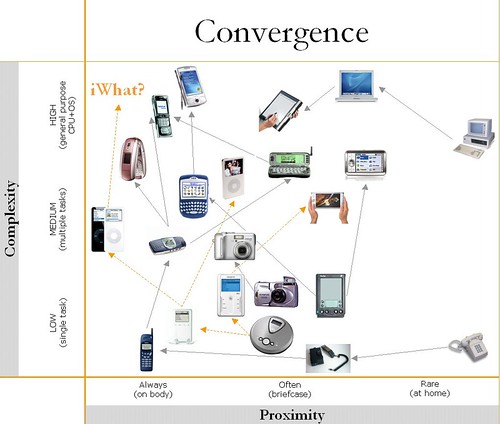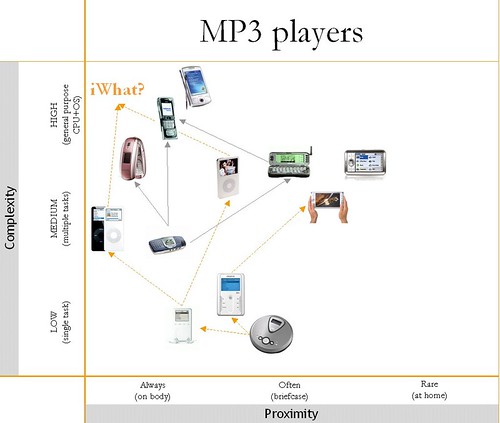Convergence of the iPod
24 May 2006Using an iPod to see how fast one is running:
With the Nike+ footwear connected to iPod nano through the Nike+iPod Sport Kit, information on time, distance, calories burned and pace is stored on iPod and displayed on the screen; real-time audible feedback also is provided through headphones. The kit includes an in-shoe sensor and a receiver that attaches to iPod. A new Nike Sport Music section on the iTunes® Music Store and a new nikeplus.com personal service site help maximize the Nike+iPod experience.
from apple.com
Interesting move! If one needed to guess a while back the type of device Nike shoes would be connected to, the choice would have been between a PDA or a mobile phone. Just add Bluetooth to the shoe, connect both and off you go. The phone had the clear advantage, since it is something people take along all the time, even when running. A runner takes his MP3 player too, of course, but until recently that was more like a single purpose device. Now Apple is positioning it as a convenient storage and visualisation device you happen to carry on you all the time. Key advantage: ubiquitous!
It also shows why it’s going to be hard to displace the iPod from its dominant market position. Apple is capitalizing on the device’s ubiquity to link it to other products and services. And because it’s a proprietary system, every link-up is another lock-in. As your shoes and your car and your stereo and your clothes become iPod-enabled, it becomes ever more difficult to abandon the little sucker.
from roughtype.com
So now there’s an attack from a less obvious contender to that Holy Grail of Ultimate Mobile Device. Let’s take a look at that crowded space:

The axes are as follows:
- the more to the left, the closer a device is to its owner, and the more it is carried by him/her. A desktop PC is far, a laptop is closer, but a mobile phone is the closest. I haven’t included embedded/implanted devices, but that would be even closer.
- the higher, the more functionality. On the bottom we see single purpose devices like a Walkman CD player, a traditional landline phone, going up we see the iPod (music, agenda, video), the PDA that is a general purpose device with smaller horsepower, and on top would be the PC/Mac, that is a fast general purpose machine.
You see all types of devices that used to be single purpose (mobile phone, PDA, MP3 player, digital camera) trying to move up and to the left, trying to get a piece of that so valuable real estate: the consumer’s breast pocket or purse. Most phones can now take pictures and sync with the agenda/email box, some PDAs can be used to make phonealls and store images, and as of recently cameras are getting cross-over features: storage device, Wifi, agenda. MP3 players either expanded to heavy portable media devices (like the Archos) or to enhanced media devices: pictures, movies. The deal with Nike shows that Apple is also aiming for something else: ubiquitous personal connected storage device. Add to that phone functionality, and you have a killer device: the “iWhat?”.

One remark: the four types of devices are not all equally crucial to its user. What is the most painful functionality to lose? I guess for most people it’s this sequence: phone, PDA, MP3, camera.
- It’s OK for most users to have a crappy camera in their phone, but not to have a camera with a crappy phone. We don’t expect to see the individual nostrils of our subject in a 1 megapixel picture, but would hate to have a fancy Nikon camera with a mobile phone that does not allow e.g. texting (SMS).
- A PDA is crucial for those with a heavy agenda, but the base PDA functions (agenda, to-do, contacts) are easily taken over by the phone or the MP3 player. If you ‘re a PDA manufacturer and you only have devices that have no MP3, no Wifi, no phone, … tough days ahead!
- I can see MP3 players adding Bluetooth and Wifi soon. This allows them to add a handsfree kit and a portable keyboard and voila: you have an awesome phone/PDA/email/IM device.
- Cameras have always had less incentive to include extra functionality, although it’s starting. The first Wifi models have already come out, allowing one to empty those 4GB flash drives without taking the card out or connecting a USB cable. It makes no sense for pro and semi-pro camera’s to add stuff like PDA or MP3. Anything with an 18-55 lens will never be an “ubiquitous” device, and if the owner can spend over €1000 for a camera, he’ll already have a phone and PDA if he needs one. For mid-price camera’s, I think that photo-related features (image stabilizer, …) are more relevant than an on-board agenda.
Incidentally, I now use a device that is all 4: my Nokia N91 is not only a phone, it has a 2-megapixel camera, a 4GB hard drive for MP3 and MPEG4 movies, 802.11G Wifi with browser and email and synchronizes with my Outlook. So I can tell you the 4 main issues with universal devices:
- weight and size: that’s an awful lot to cram into one package
- stability: you need an OS that can run several applications at once. Apparently, that’s not an obvious task
- single point of failure: when it fails, you have nothing left. Your phone is gone, your contacts are gone, your music is gone… Back to the stone age. The most common cause of this brings us to the last and most important issue:
- battery: I pity the battery. It’s surprisingly small for that big phone, and when one uses the MP3 player often, the odds of it lasting longer than a day are very small indeed. And when it dies … (see 3.)